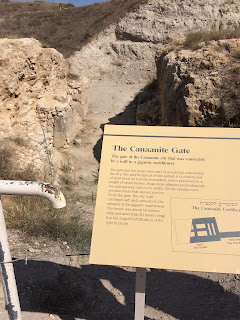Tel Gezer: More Than One Ancient City
by Em Samuels, 11th grade, Southern California
Today the group and I visited Tel Gezer, one of the most ancient cities in all of Jewish history. However, Tel Gezer is not the ruins of one era, but archaeologists have in fact discovered twenty six layers of separate civilizations, spanning over at least a thousand years. While incredibly interesting, I found myself asking why the hell the staff took us to this place because is was SO hot today... which led me to think, "why did people settle here for so many years?"
This bring me to what we learned today to be known as "The Four D's of Civilization". To build a successful civilization, one must have all four of the following:
This bring me to what we learned today to be known as "The Four D's of Civilization". To build a successful civilization, one must have all four of the following:
- Drink, or a water source. Originally built by the Canaanites about 4,000 years ago, the city of Gezer has an underground water system. Over the course of many years, the Canaanites chiseled away to create a 40 foot tunnel to access a subterranean water basin, creating sustainability for the city.
- Dinner, or a consistent food source. Gezer's land is fertile, and the grounds surrounding the archaeological sights are covered in grape vines and olive trees. Having such good agricultural soil and the livestock that were tended by the peole, Tel Gezer was able to thrive for an entire millennium.
- Defense, or a way to protect the city from conquerors. The city of Tel Gezer built an enormous wall surrounding the hill that it was built on, some of which you can still see today. The front gate, the only entrance, was where the citizens of Tel Gezer held their trials and marketplaces, among many other cultural occurrences.
- Dollars, or a stable economy. Gezer was built (26 different times) on a hill about 10 miles from the Mediterranean Sea, right along the ancient trade route that cut from the coast to Jerusalem. It was a minor city, mostly used as a trade stop on the way inland. In fact, if you look to the east, you see Highway 1, the first paved road in Israel, which was built exactly on top one of the major trade routes that runs North to South (parallel to the Judean Hills).
Today we also learned about Canaanite religion and how it coincided with their day to day lives. When these people asked for rain (given that Israel is a desert), they first prayed to their gods. When the rains did not come, they started sacrificing animals. Whenthat didn't work, they kidnapped women and held them as "temple prostitutes" who had sex with powerful men in order to please the gods' sex drives. When even that did not work, they began sacrificing their own children. Because of all of these reasons, theTanakh condemns the Canaanite lifestyle, and even forbids Jews from intermarrying with them. Below is a picture of the alter where baby boys were sacrificed.
So today was quite eventful. I hiked through hot, dusty hills to see some of the most important physical evidence of ancient life in the Holy Land. I sat with my back against the walls of a 3,000 year old building and learned some very interesting facts about why Jews have lived in this specific area for all of these years.
Em Samuels has her own blog about time in Israel at:





